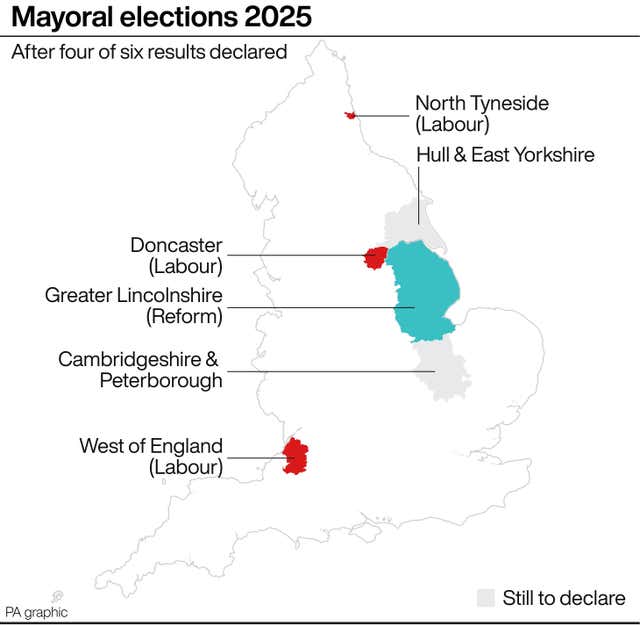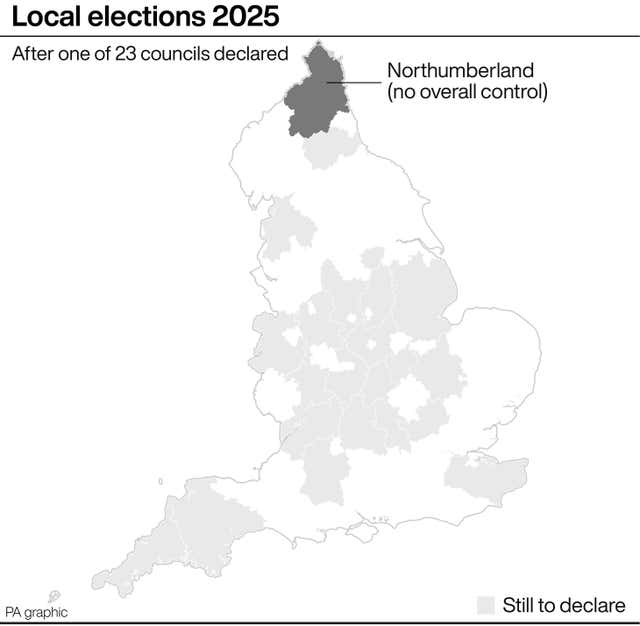Local and mayoral elections: Key results so far
No party won more than a quarter of the share of the vote in the West of England mayoral election.

Reform has won its first-ever regional mayor in England while Labour managed to hold on to a hat-trick of mayors across the country, in the first results from this year’s local elections.
Only one council, Northumberland, has so far declared all its results, with Reform making gains at the expense of both Labour and the Conservatives.
Counting will get under way on Friday morning in the rest of the local authorities that held elections on Thursday, with results not due until later in the day.
Two further mayoral contests, Cambridgeshire & Peterborough and Hull & East Yorkshire, are also due to declare on Friday afternoon.
Here are the key results from the elections so far:
– Greater Lincolnshire
Reform enjoyed a comfortable victory in this brand new mayoral position, winning 42.0% of the vote, well ahead of the Conservatives in second place on 26.1%.
Labour finished a distant third on 12.3%.
The result suggests Reform are likely to do well in the separate elections for Lincolnshire county council, which will be counted and declared later on Friday.
Winning candidate Dame Andrea Jenkyns is a former Conservative MP and becomes Reform’s first-ever directly-elected regional mayor.
She won on a very low turnout of 29.9%, however.

– North Tyneside
Labour held on to the mayor of North Tyneside by a tiny margin, with Reform coming a close second.
The area is one of Labour’s north-east heartlands and the party’s candidate Karen Clark was favourite to win, but the result was much closer than expected: Ms Clark received 16,230 votes, just 444 ahead of Reform candidate John Falkenstein (15,786).
There was clear evidence here of the electorate splitting between various parties, as Labour won with fewer than a third of the votes cast (30.2%), while Reform got 29.4%, the Conservatives 20.5%, the Greens 7.4% and the Liberal Democrats 6.4%.
Ms Clark’s predecessor as Labour mayor, Norma Redfearn, had held the position since 2013 but chose not to stand this time.
Turnout here was 33.6%.
All this year’s mayoral elections are being held using the first-past-the-post system – the same as for parliamentary elections – which is different to the previous contests in 2021, when voters could express a first and second preference.
This means the results of this year’s elections are not directly comparable with those from four years ago.
– Doncaster
Labour’s Ros Jones won a fourth term in office in Doncaster, having held the position since 2013.
As in North Tyneside, Reform finished a close second, winning 23,107 votes to Ms Jones’ 23,805, giving her a majority of just 698.
No party managed to win more than a third of the vote, with Labour taking 32.6%, Reform 31.7% and the Conservatives – who came second in 2021 – on 26.0%.
The Greens finished a distant fourth on 3.4%, while turnout was 32.1%.
– West of England
Labour also held on to West of England mayor, albeit on an even lower share of the vote than at North Tyneside or Doncaster.
Helen Godwin won the contest with a majority of 5,945, but did so with just 25.0% of the vote, ahead of Reform on 22.1%, the Greens on 20.0%, the Conservatives on 16.6% and the Lib Dems on 14.0%.
The result is another example of how multi-party politics is becoming increasingly common in England, with all five parties finishing within a range of just 11 percentage points.
The post of West of England mayor covers Bath & North East Somerset, Bristol and South Gloucestershire: parts of the country where Labour, the Lib Dems and the Greens all enjoyed success at the 2024 general election, but which also contain pockets of traditional Conservative support.
The outgoing mayor, Labour’s Dan Norris, was recently suspended from the party after he was arrested on suspicion of sexual offences.
Turnout here was 30.0%.

– Northumberland
The Conservatives remain the largest party on Northumberland council, but won only 26 of its 69 seats, just ahead of Reform on 23, with Labour some way behind on eight, independents on seven, the Lib Dems on three and the Greens on two.
Reform had no seats on the council before the election and have made gains at the expense of both the Tories and Labour.
With no party having enough councillors for a majority in Northumberland, the council is classed as being in no overall control – as was the case before the election, when the Tories ran the council as a minority administration.
Parties are now likely to begin negotiations over how to run the new-look council, with options including a formal coalition, a less formal agreement of support, or one or more parties attempting to take control as the largest minority group.





